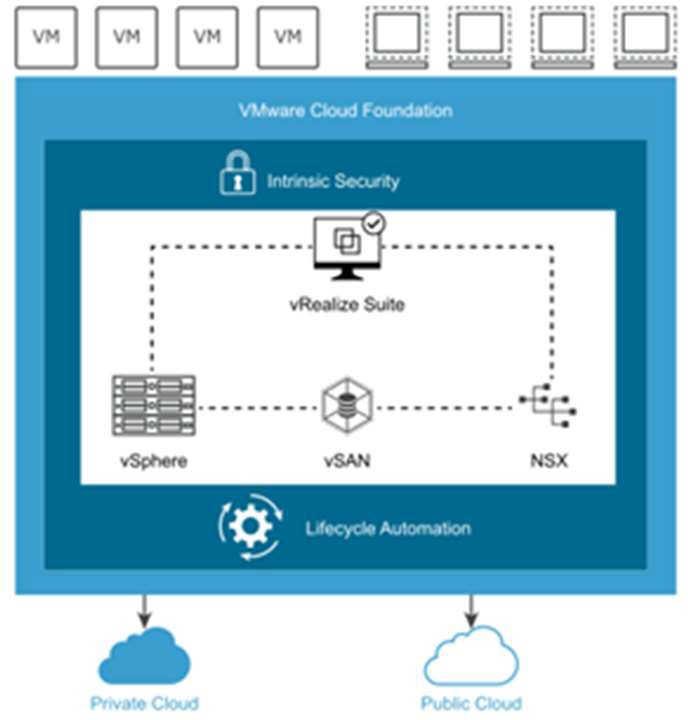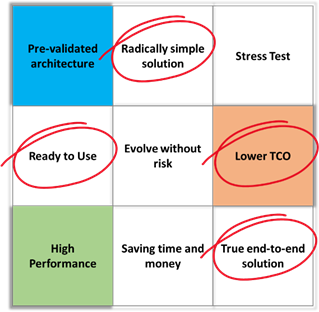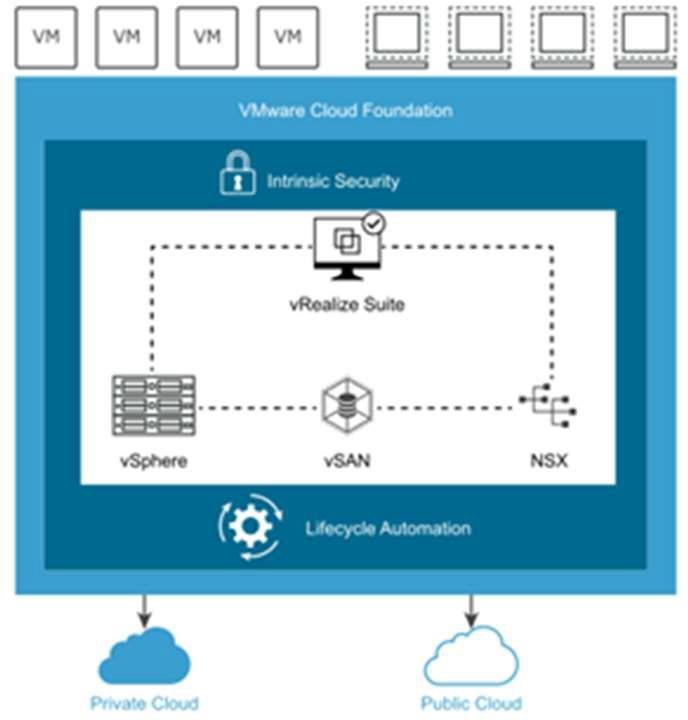

VMware Cloud Foundation on Dell Hyperconverged Infrastructure (Dell EMC vSAN)
Download PDFFri, 13 Jan 2023 10:00:33 -0000
|Read Time: 0 minutes
Summary
Dell EMC vSAN Ready Nodes are preconfigured, tested and certified hyperconverged infrastructure to run VMware Cloud Foundation. Each Ready Node includes the right amount of CPU, memory, network I/O controllers, within a vSAN hyperconverged infrastructure cluster for a private cloud solution.
Rather than starting from the scratch of deploying varied virtualization tools for compute, network, storage, etc., vSAN Ready Nodes helps start from a preconfigured layer to deploy VMware Cloud Foundation, which helps customers provision infrastructure automatically and reliably through workload domains. These Ready Nodes help reduce human error by reducing the time taken to choose and validate the right cloud infrastructure, while greatly accelerating the time required to provision ready to use infrastructure from weeks to just few hours.
Introduction to the Technology
VMware Cloud Foundation is a unified software defined data center solution that bundles compute, storage, network virtualization and cloud monitoring and management platform. VMware Cloud Foundation on Dell EMC AMD vSAN Ready Nodes platform can be deployed either on- premises or hosted with a service provider as a private cloud or run as a service within or integrate to, a public cloud.
VMware Cloud Foundation Architecture
Cloud Foundation can be deployed as two types of architecture model - standard and consolidated. A standard architecture model includes a dedicated management domain, with dedicated infrastructure created during deployment phase, whereas a consolidated architecture is deployed on a smaller infrastructure footprint of six or fewer hosts, and both the management and workload domains run in the management domain.

VMware Cloud Foundation extends the benefits of compute, storage and network virtualization to legacy data centers and their cumbersome management of multiple siloes of infrastructure and simplifies the provisioning, orchestration, monitoring and management of infrastructure resources with an integrated software defined data center platform that is the foundation for both private and public cloud environments.
Infrastructure for hosting VMware Cloud Foundation as Standard Architecture Model
Dell EMC PowerEdge hyperconverged (VMware vSAN) infrastructure are one of the building blocks in the Dell EMC solution portfolio, wherein we can deploy the VMware Cloud Foundation solution stack. A hyperconverged infrastructure (vSAN Ready Node) improves the efficiency and management of complex data center infrastructure by leveraging the capabilities that a vSAN Ready Nodes provide as the basic building block for the Cloud.
he following are the minimum hardware required for the Standard Architecture.
For Management Domain.
The Management domain hosts the infrastructure workloads and requires a minimum of 4-hosts.
For Virtual Infrastructure Workload Domain.
The Virtual Infrastructure Workload Domains host the tenant workloads and consists of a minimum of one cluster of 4 hosts or more. Hosts within a single cluster must be homogeneous.
The below table lists the infrastructure required to host the VMware Cloud Foundation as a Standard Architecture Model.
Description | Configuration | Qty | Notes |
Management Cluster (4-vSAN Ready Nodes) | 4 | 4-Node Management Cluster | |
| 1S 8C (for All Flash) | 2 | All Flash nodes within a cluster |
1S 8C (for Hybrid) | 1 | Nodes with a combination of flash and spindle disks within a cluster | |
| 192 GB | 1 |
|
| 16GB Boot Device | 1 | Local Media |
NVMe or SSD | 1 | Caching Tier | |
SSDs or HDDs | 2 | Capacity Tier | |
| 10 GbE or higher | 2 | (IOVP Certified) |
| 1 GbE (Optional) | 1 |
|
| |||
VI Workload Domain (4-Compatible vSAN Ready Nodes-cluster minimum) | 4 | Choose from the VCG list of validated vSAN RN for User Workload | |
|
|
|
As per user-workload Sizing |
|
|
| |
|
|
| |
|
|
| |
|
|
| |
| |||
Table-1. Hardware Configuration – For Standard Architecture
The below table lists the AMD Processor based servers validated for vSAN Ready Nodes.
PowerEdge vSAN RN | No. Of Sockets | No. Of Cores | AMD CPU Platform |
| 1S | 32/64 |
AMD EPYC 7502, AMD EPYC 7742 |
| 2S | 32/64 | |
| 1S | 32/64 | |
| 2S | 32/64 | |
| 2S | 32/64 |
Table-2. List of AMD platform-based PowerEdge vSAN Ready Nodes
In Conclusion
Dell PowerEdge AMD based vSAN Ready Nodes are pre-configured, validated and certified to reduce deployment challenges, reduce time and increase efficiency, and in-turn helps ease the setting up of a VMware private cloud.
The availability of a validated vSAN Ready nodes of different configurations help customers scale strategically and ensures that critical IT resources are configured as per standards for maintaining productivity and competitive cloud advantage.
Related Documents

Dell EMC vSANReady Node Certification
Fri, 13 Jan 2023 10:00:33 -0000
|Read Time: 0 minutes
Summary
Dell EMC vSAN Ready Nodes are simple solution that help accelerate VMware vSAN deployments, as the hardware is pre-configured and tested with optimally configured CPU, memory, Network Interface Controllers, SSD and HDD, pre- loaded with VMware vSphere and vSAN software, offered in varied capacities for different workloads, with a certification from both Dell EMC and VMware.
Dell EMC vSAN Ready Nodes lessen project risks and reduce the time taken to procure hardware and software, build, validate, certify and run a hyperconverged solution.
Introduction to the Dell EMC vSAN Ready Node Certification
Dell EMC vSAN Ready Nodes are hyperconverged building blocks built on Dell EMC PowerEdge servers that are preconfigured, tested and certified to run VMware vSAN™, a radically simply software-defined storage solution. Dell EMC vSAN Ready Nodes are offered in varied configurations designed to meet VMware vSAN specifications and are ideal for on-premises and cloud environments. For customers, it simplifies the path to HCI and reduces risks with a validated, tested, and certified ready to run Dell EMC vSAN Ready node.
The Certification Process
All Dell EMC vSAN Ready Nodes are required to go through a certification process. This involves jointly testing for performance, feature and faults, different types and quantity of CPU's, memory and disks, network controllers, and stress tests for a period that ensures the robustness and resiliency of the hardware.
The following diagram depicts the certification process for the Dell EMC vSAN Ready Nodes.
 Figure-1. Dell EMC vSAN Ready Node certification process.
Figure-1. Dell EMC vSAN Ready Node certification process.
Certification Parameters and Outcome
VMware vSAN, is built from the ground up and certified to be listed on the VMware Compatibility guide-VCG website. Each vSAN Ready Node is configured with the right hardware, specific firmware and driver versions, configuration type of Hybrid or All-Flash drives, ESXi version, combined with the best performance and availability of support used in a VMware vSAN Cluster. The certification process requires the base server platform, and the driver versions of the peripheral devices of the hardware under test be I/O Vender Partner certified. This ensures that the Ready Nodes listed in the vSAN Compatibility Guide are specific versions for every certification and not just minimums. For customers, this means a vSAN HCI node has been tested thoroughly with the base hardware and exact configurations that is listed in the VCG, enabling in choosing the ‘Most Optimized vSAN Cluster’ configuration a simple task. A change in this combination requires recertification even if a specific component has been tested with or changed from the previous version. Dell EMC vSAN Ready Node Certification happens on three levels: vSAN Ready Nodes-comprising of one or more chassis, individual components, such as a Storage I/O Controller and PCIe or NVMe devices, with the rest of the base hardware made of certified components.
Benefits
Hyperconverged solutions offer inherent benefits, not just consolidated hardware with a license. Dell EMC vSAN Ready Nodes provides enterprises the right Ready Node profiles for your workloads, a single SKU, a modular and scalable platform with a lower TCO compared to a disparate solution and ease of use in managing resources. With the Dell EMC vSAN Ready Nodes created jointly with Dell EMC and VMware, hundreds of hours of testing and certification makes it the obvious choice for any enterprise’s need for a hyperconverged solution.

Figure-2. Benefits of Certified VMware vSAN solution.
In Conclusion
Dell EMC vSAN Ready Nodes are an ideal choice for enterprises planning to adopt a Hyperconverged Infrastructure solution. Choose a pre-validated reference architecture designed and tested to utilize the latest server and storage technologies that are ready to use as an exact end-to-end solution.
Today's enterprises face more stringent IT budgets, and customers are exploring technologies to lower the total cost of ownership drastically. Dell EMC vSAN Ready Nodes help streamline HCI adoption and reduce costs with a scale-up/scale-out architecture that adapts to a rapidly changing business need. To learn more on Dell EMC vSAN Certifications visit the website here.

VMware Cloud Foundation on Dell EMC vSAN Ready Nodes
Fri, 13 Jan 2023 10:00:33 -0000
|Read Time: 0 minutes
Summary
Dell EMC vSAN Ready Nodes are preconfigured, tested and certified hyperconverged infrastructure to run VMware vSAN, a radically simple software-defined storage. Each Ready Node includes the right amount of CPU, memory, and network I/O controllers, within a vSAN hyperconverged infrastructure cluster to run a your private or hybrid cloud solution. Rather than starting from scratch deploying varied virtualization tools for compute, network, storage, etc., vSAN Ready Nodes start with a preconfigured layer to deploy VMware Cloud Foundation, which helps customers provision infrastructure automatically and reliably through workload domains. These Ready Nodes help mitigate human error by reducing the time taken to choose and validate the right cloud infrastructure, while greatly accelerating the time required to provision ready to use infrastructure from weeks to just few hours.
Introduction to the Technology
VMware Cloud Foundation is a unified software-defined data center solution that bundles compute, storage, network virtualization and cloud monitoring and management. VMware Cloud Foundation on Dell EMC vSAN Ready Nodes with AMD processor can be deployed either on- premises, hosted with a service provider as a private cloud or run as a service within or integrate to a public cloud.
VMware Cloud Foundation Architecture
VMware Cloud Foundation can be deployed as two types of architecture model - standard and consolidated. A standard architecture model includes a dedicated management domain, with dedicated infrastructure created during the deployment phase, whereas a consolidated architecture is deployed on a smaller infrastructure footprint of six or fewer hosts, and both the management and workload domains run in the management domain.
VMware Cloud Foundation extends the benefits of compute, storage, and network virtualization to legacy data centers and their cumbersome management of multiple siloes of infrastructure. Cloud foundation also simplifies the provisioning, orchestration, monitoring and management of resources with an integrated software defined data center platform that is the foundation for both private and public cloud environments.

Infrastructure for hosting VMware Cloud Foundation as Standard Architecture Model
Dell EMC vSAN Ready Nodes are one of the building blocks in the Dell EMC solution portfolio, wherein we can deploy the VMware Cloud Foundation solution stack. A hyperconverged infrastructure (vSAN Ready node) improves the efficiency and management of complex data center infrastructure by leveraging the capabilities that a vSAN Ready nodes provides as the basic building block for the Cloud.
The following are the minimum hardware required for the Standard Architecture.
For Management Domain.
The Management domain hosts the infrastructure workloads and requires a minimum of 4-hosts.
For Virtual Infrastructure Workload Domain.
The Virtual Infrastructure Workload Domains host the tenant workloads and consists of a minimum of one cluster of 4 hosts or more. Hosts within a single cluster must be homogeneous.
The below table lists the infrastructure required to host the VMware Cloud Foundation as a Standard Architecture Model.
Description | Configuration | Qty | Notes |
Management Cluster (4-vSAN Ready Nodes) | 4 | 4-Node Management Cluster | |
| 1S 8C (for All-Flash) | 2 | All-Flash nodes within a cluster |
1S 8C (for Hybrid) | 1 | Nodes with a combination of flash and spindle disks within a cluster | |
| 192 GB | 1 |
|
| 16GB Boot Device | 1 | Local Media |
NVMe or SSD | 1 | Caching Tier | |
SSDs or HDDs | 2 | Capacity Tier | |
| 10 GbE or higher | 2 | (IOVP Certified) |
| 1 GbE (Optional) | 1 |
|
| |||
VI Workload Domain (4-Compatible vSAN Ready Nodes-cluster minimum) | 4 | Choose from the VCG list of validated vSAN RN for User Workload | |
|
|
|
As per user-workload Sizing |
|
|
| |
|
|
| |
|
|
| |
|
|
| |
Table-1. Hardware Configuration – For Standard Architecture
The below table lists the AMD-based Dell EMC PowerEdge servers validated for vSAN Ready Nodes.
Dell EMC vSAN Ready Node | No. Of Sockets | No. Of Cores | AMD CPU Platform |
| 1S | 32/64 |
AMD EPYC 7502, AMD EPYC 7742 |
| 2S | 32/64 | |
| 1S | 32/64 | |
| 2S | 32/64 | |
| 2S | 32/64 |
Table-2. List of AMD platform-based PowerEdge vSAN Ready Nodes
In Conclusion
Dell EMC vSAN Ready Nodes on an AMD-based server platform are pre-configured, validated, and certified to reduce deployment challenges, increase efficiency, and in turn, helps ease the setting up of a VMware private cloud.
With one of the broadest vSAN Ready Node portfolios in the market, Dell EMC helps customers scale strategically and ensures that critical IT resources are configured as per standards for maintaining productivity and competitive cloud advantage.


